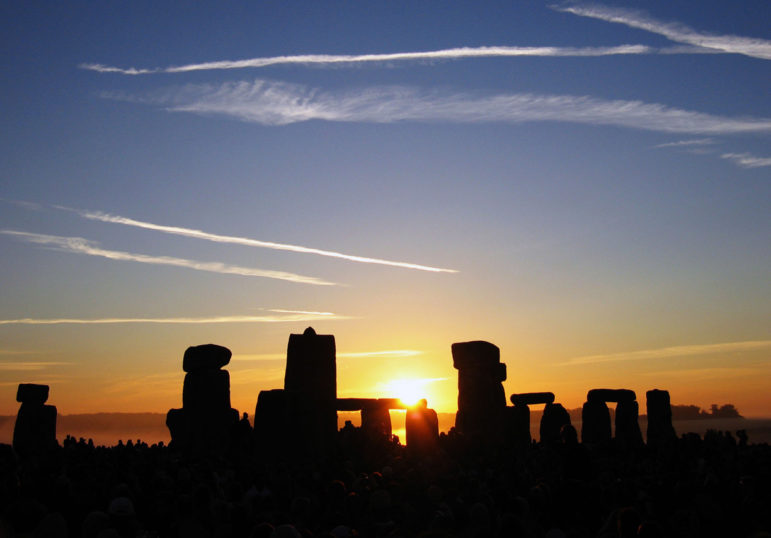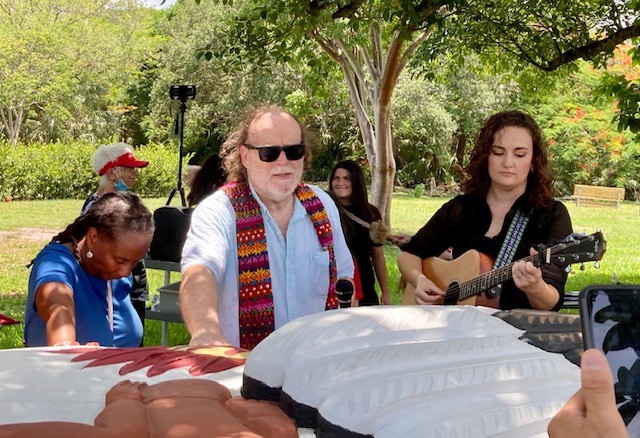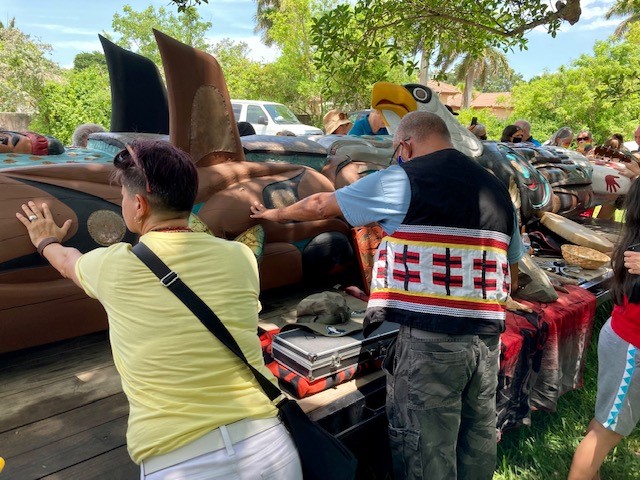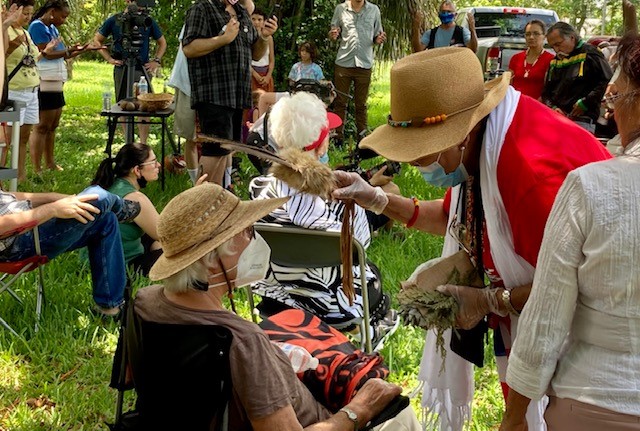
CC BY-SA 2.0, https://commons.wikimedia.org/w/index.php?curid=195581
WILTSHIRE, England – Despite the shift in COVID-19 restrictions being extended and warnings from the English Heritage Trust, hundreds of people showed up at Stonehenge for Summer Solstice.
The English Heritage Trust, the charity that manages Stonehenge and other historical sites, had originally planned to welcome back large groups of visitors for Solstice. Unfortunately, British Prime Minister, Boris Johnson announced last week that COVID-19 restrictions would be extended for another four weeks, until July 19.
The extension of the restrictions was done in hopes of allowing extra time for getting more of the population vaccinated especially in light of a possible third wave of infections due to the Delta variant becoming the dominant strain in the U.K.
The English Heritage Trust announced mid-week that due to the extension of the restrictions, only small groups of 30 or less would be allowed to enter Stonehenge with priority given to Pagan and Druid groups who registered in advance being allowed access prior to and after sunset and sunrise.
Unfortunately, a number of people breached the protocols and entered the grounds by climbing over fencing and took over the site, which caused the livestream of the sunrise to disrupted for roughly eight minutes. Footage tweeted by Stonehenge U.K. shows the situation:
Stonehenge Summer Solstice #sunrise #SummerSolstice pic.twitter.com/uosGqOCZG8
— Stonehenge U.K (@ST0NEHENGE) June 21, 2021
Police eventually dispersing the crowd and the livestream was able to be resumed. It was not explained how or why the attendees caused the feed of the sunrise to be disrupted.
Ed Shires, host of the livestream told reporters, “We have been disappointed that a number of people have chosen to disregard our request to not travel to the stones this morning, and that is the reason why we haven’t been able to bring you the pictures that we would have liked to have done.
“It is disappointing to see that happen, but unfortunately in those kind of situations we have to put the safety of our staff members first, and that’s why we have had some interruption this morning.
“We have been told by police that people have now been dispersed and the situation is under control.”
Not all of those chose to ignore the restrictions of gathering in groups of more than 30 chose to violate the space. Footage posted to the Facebook page Stonehenge Dronescapes, shows a ritual led by a Druid outside the fence and in a nearby meadow:
24 miles (38 km) to the north, Avebury also reported problems with lanes being obstructed by vehicles parked in places they were not allowed. Hundreds of vehicles were parked along roads near the site.
The Avebury Parish Council had requested a number of temporary road closings, and restrictions on parking prior to the solstice, which seemed to have merely pushed people attempting to get to Avebury further out and closer to the village of Ridgeway to try to find places to park.
The authorities closed access to parts of the Ridgeway Trail, a stretch of passage that spans 87 miles (140 km) from Avebury all the way up to Ivinghoe Beacon in Buckinghamshire to prevent damage to nearby fields and for the sake of public safety.
In a normal year Stonehenge attracts as many as 30,000 people for solstice events, and Avebury at least 10,000.
⊕ ⊕ ⊕
 MIAMI – The Lummi Nation House of Tear Carvers has taken on an extraordinary project, to deliver a totem pole they created to President Biden in the nation’s capitol.
MIAMI – The Lummi Nation House of Tear Carvers has taken on an extraordinary project, to deliver a totem pole they created to President Biden in the nation’s capitol.
The totem pole, tipping the scale at 5,000 pounds, and measuring 25 feet tall and about 43 inches wide, represents all sacred land and sites, and was designed to help bring attention to the need to protect and restore sacred sites, which encompasses a variety of landscapes and waterways across the country.
The Lummi Nation is made up of about 5,000 tribal members near Bellington, Washington.
The master carver of the pole, Jewell “Praying Wolf” James, a Lummi Nation citizen described the totem pole as “a reminder of the promises that were made to the first peoples of this land and waters.” He was quoted by the Washington Post as saying he hopes that people will “share in their responsibility to safeguard the sacred sources of life — Earth, water and sky.”
The massive totem pole is making its way across the country and was in Miami at the Unitarian Universalist Congregation of Miami on Sunday, where the community was invited to come the stories and to then share their hopes, prayers, and even grief with the totem pole.
Rev. Tom Capo, Developmental Minister of the Unitarian Universalist Congregation of Miami, welcomed the totem pole and the Lummi Nation members noting he and the congregation felt an obligation to participate in the toitem’s journey. “We do the work necessary to help preserve the land and help the people of the land,” he said. Members of the congregation participated in a blessings of the totem on its journey to Washington, D.C.
The House of Tears Carvers of the Lummi Nation have created more than 15 totem pole journeys over the past 20 years to help raise awareness of the threats to natural and cultural heritage, tribal sovereignty, public health, and climate change North America is facing.
The journey of this totem pole has been named the “Red Road to DC: A Totem Pole Journey for the Protection of Sacred Places.” It is scheduled to travel to a variety of sacred sites across the United States so that it will carry the energy of those places within when it arrives at the U.S. Capitol on July 29.
The totem pole will be installed for two days on the Mall and outside the entrance of the National Museum of the American Indian in D.C.
The Washington State National History Museum director, Beka Economopoulos said, “It’s going to carry the spirit of the land it visits and the power and prayers of the people along the way to the symbolic heart of the nation.” She said keeping the pole in D.C. would make it a “monument to the protection of sacred places and a way of relating to the land.”
Carved from a 400-year-old red cedar tree, the totem pole bears a number of depictions that reflect native culture and practices. One is of an eagle “headed downward in a dive to the Earth,” representing a Lummi belief that the eagle is “bringing the spiritual power to impregnate the Mother Earth.”
Another shows a woman with a girl kneeling near her, according to master carver, James, the scene is meant to depict grandmothers across the country who are raising and teaching their granddaughters traditional Native American ways. There are also seven tears near this scene that are in place to reflect the seven generations of Native people around the globe who have suffered from the trauma inflicted upon them by non-Native peoples.
“They represent visions, dreams and stories that are handed down and shaped through each generation,” James said.
Other symbols include a salmon and a moon, as well as that of a man praying, and a red hand to represent the hundreds of indigenous women who are murdered or go missing each year.
“We sat nation-to-nation and signed agreements,” Judith LeBlanc, director of the Native Organizers Alliance said. “We gave up land that mattered in order to receive health care, education and housing. Those treaty rights have been denied all through history.”
In other news:
-
- The latest update to the discrimination suit being brought by Tammy McCoy against PAN American Group LLC, which owned and operated the Pleasant Hills, Pennsylvania Panera bread where McCoy had worked, is that attorneys for Panera Bread have requested the case either enter into arbitration or be dismissed. Panera’s attorneys told the court that McCoy signed a dispute resolution program (DRP) agreement when she was hired that subjected claims like hers to binding arbitration. “By electronically signing the DRP during the onboarding process, McCoy acknowledged receipt of, and agreement to, the DRP which contains the parties’ agreement to arbitrate all disputes arising between them,” Panera said in a brief to the court late last month. “While McCoy was not precluded from pursuing her claims through the [Equal Employment Opportunity Commission], she expressly waived any right to pursue such claims in court litigation.” McCoy’s attorney said McCoy would oppose arbitration since McCoy contends that her general manager, Krista Stephen, created McCoy’s employee password and electronically signed the paperwork that was submitted at the end of McCoy’s first day on the job. “The plaintiff did not digitally read, sign or acknowledge the paperwork. The plaintiff was never given a copy of the arbitration agreement and did not know that one existed,” McCoy’s brief opposing arbitration filed on June 14 said, “The ‘electronic signature agreement’ bears a ‘date-stamp’ of 1:33 p.m. The plaintiff was not in the store and could not have ‘signed’ it because she had already left for the day and was on the Y46 bus heading home.” The brief continued, “Tammy McCoy did not see, sign or otherwise consent or agree to be bound by the arbitration agreement at issue. An agreement to arbitrate may only be found as a matter of law when there are no genuine disputes of material facts regarding the formation of the agreement when viewed in the light most favorable to the nonmoving party. In this case, the issue is whether both parties manifested an intention to be bound by the agreement.” McCoy and her attorney intend to continue to move forward with the case in federal court.
-
- Last week in a unanimous decision, the 9th Circuit Court of Appeals confirmed that the Yakima Nation was correct about its treaty lands in Washington state. The ruling concerned a parcel known as Tract D of the 1.4-million-acre Yakama Reservation, which was set aside by treaty more than 150 years ago in recognition of its importance to the tribe and its citizens. The result of the 9th Circuit’s ruling forecloses Klickitat County from prosecuting Yakama citizens and other Indians for most offenses on the reservation, while the jurisdiction over juvenile delinquency, the decision notes as an example, is shared between the tribe and the federal government. The decision is seen as big win for the Yakima Nation.
The English Heritage Trust broadcast live both the Summer Solstice sunset yesterday and the sunrise this morning on Facebook.
The weather in Wiltshire, England was overcast and made for a less visually dramatic presentation than the Winter Solstice last year. The lack of a spectacularly visual sunset and sunrise did little to dampen the enthusiasm of the thousands of people around the world who tuned in to view both events live and commented with “Happy Solstice” wishes and thanking the English Heritage Trust for making the broadcast free to watch.
The live feed was briefly disrupted for about 8 minutes and replaced with previously recorded footage when people breached the boundaries of the site.
Tarot of the week by Star Bustamonte Deck: Tarot of Mystical Moments,
Deck: Tarot of Mystical Moments,
by Catrin Welz-Stein, published by U.S. Games Systems, Inc.Card: Knight of Cups
This week is likely to offer opportunities to experience and express deeply held emotions, as well as being sensitive to the feelings of others. There is also the potential for romantic gestures underlined by charm.
Conversely, emotional outbursts that exhibit a lack of regard for the impact to others, and expression of a temperamental nature are also possible.
Decks generously provided by Asheville Pagan Supply.
The Wild Hunt is not responsible for links to external content.
To join a conversation on this post:
Visit our The Wild Hunt subreddit! Point your favorite browser to https://www.reddit.com/r/The_Wild_Hunt_News/, then click “JOIN”. Make sure to click the bell, too, to be notified of new articles posted to our subreddit.


